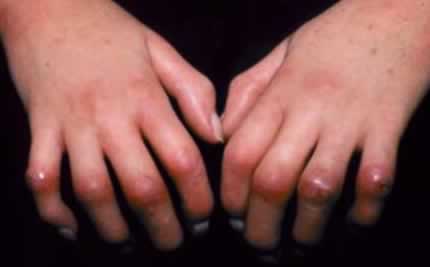Scleroderma
Scleroderma is a skin disease where excess collagen
is produced, thus resulting in the formation of scar-like skin
thickening similar to that of a healed burn wound.
Symptoms of Scleroderma
The symptoms of scleroderma are:
- Scar-like thickening, hardening, and tightness of the skin
- Swelling in the hands and feet
- Swelling and redness around the nail and cuticles
- Itching
- Pain and numbness in the hand
- Change in skin color when exposed to cold or stress
- Joint stiffness
- Difficulty swallowing
- High blood pressure
Scleroderma generally begins in the fingers, and for most people,
are confined to this area. In serious cases, collagen formation
also occurs in the lung, kidneys, and esophagus.

Scleroderma on the fingers.
How Many People Get It?
Approximately 300,000 people in the United States have scleroderma.
It affects mostly middle-aged women, although it can occur in
both men and women of all ages.
Prevention of Scleroderma
People with scleroderma can prevent flare-ups by:
- Avoiding dry skin
Wash your hand and bathe with moisturizing soap, and apply moisturizer
to the skin right afterwards.
- Wear warm clothings and gloves during cold weather
- Performing stretching exercises to increase flexibility of
tight skin
- Avoid smoking
Treatment of Scleroderma
There is no cure for scleroderma. Doctors may prescribe corticosteroid
cream to minimize itching.


